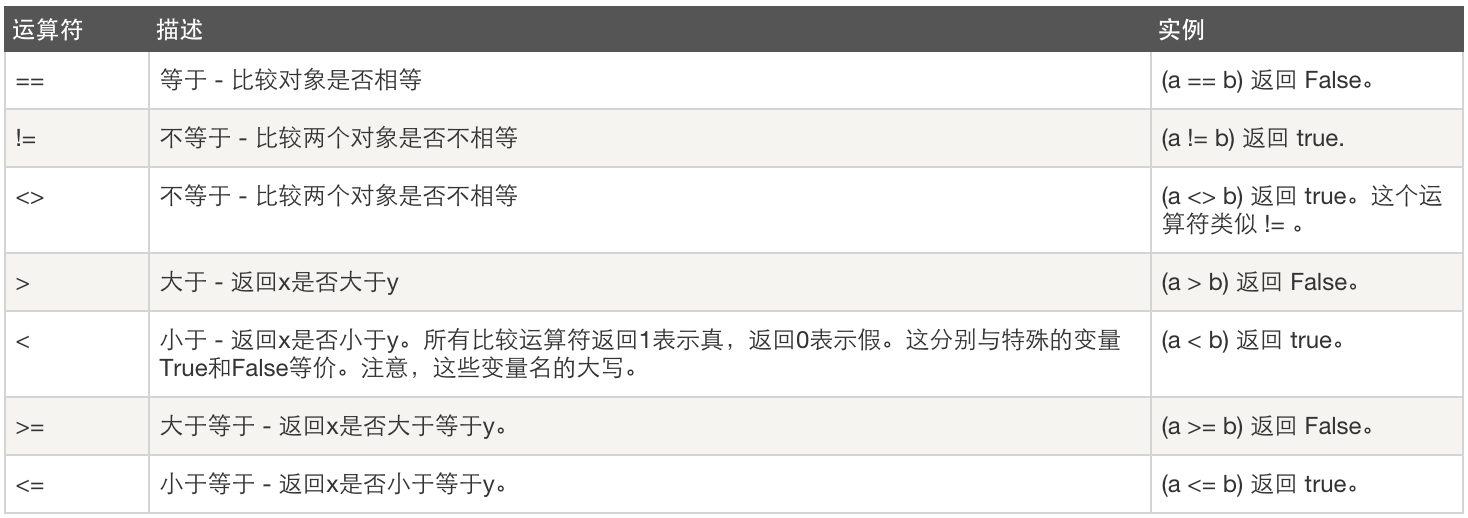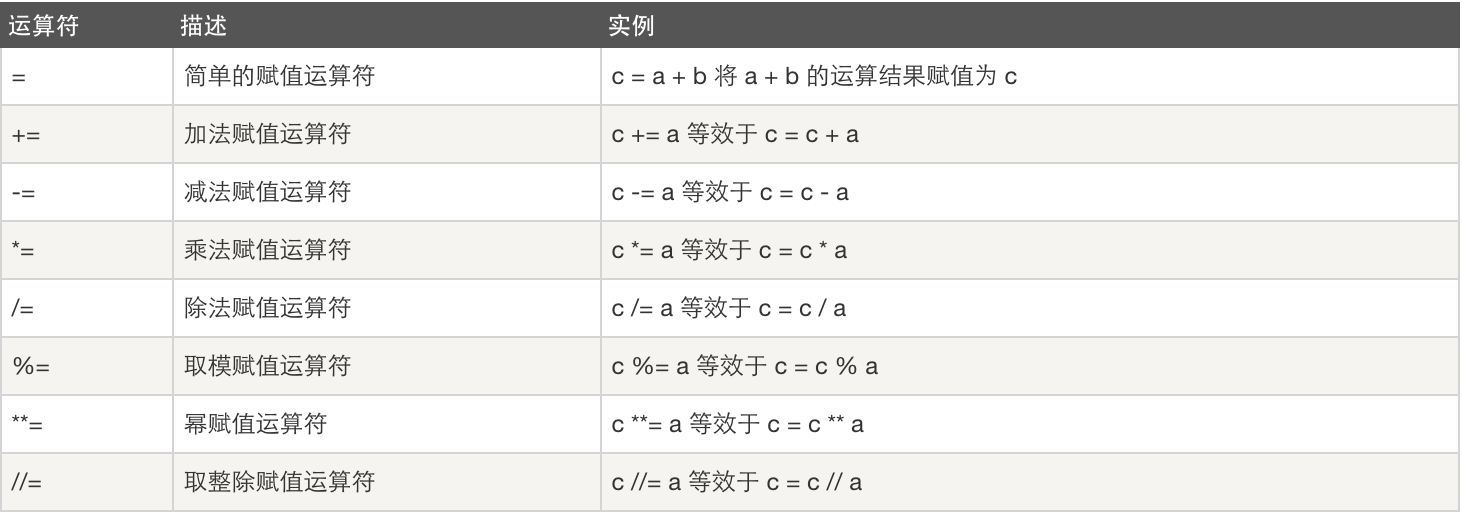输入输出
基本的输入和输出:
输入:input()
输出:print() 打印

username=input('Please input your name:') passwd=input('Please input your password:') print(username) print(passwd)

# !/usr/bin/env python # -*- coding: utf-8 -*- import getpass # 将用户输入的内容赋值给 name 变量 pwd = getpass.getpass("请输入密码:") # 打印输入的内容 print(pwd)
格式化输入输出**:

name='egon' print('my name is '+name) ''' my name is egon '''

name='egon' print('my name is ',name) ''' my name is egon '''

name='alex' age='25' print('my name is %s ,my age is %s ' %(name,age)) ''' my name is alex ,my age is 25 ''' ''' 字符串是 % s; 整数 % d; 浮点数 % f ''' #例2 users=[ {'username':'alex','age':18,'job':'teacher','hobble':'girl'}, {'username':'egon','age':28,'job':'teacher','hobble':'boy'}, ] msg=''' ------------info of %s------------- Name : %s Age : %s Job : %s Hobbile : %s -------------end-------------------- ''' %(users[1]['username'],users[1]['username'],users[1]['age'],users[1]['job'],users[1]['hobble']) print(msg) ''' 打印结果: ------------info of egon------------- Name : egon Age : 28 Job : teacher Hobbile : boy -------------end-------------------- '''

##字符串格式化 format ##2种方式 ##索引的方式 # user_info='我叫{0},今年{1}' # v=user_info.format('alex',23) # print(v) ##传参数 # user_info='我叫{name},今年{age}' # v=user_info.format(name='alex',age=23) # print(v) ##format_map 传值是字典形式 # user_info = '我叫{name},今年{age}' # v = user_info.format_map({'name':'alex','age':23}) # print(v)
运算符
算数运算:

比较运算:

赋值运算:

逻辑运算:

成员运算:

身份运算:

位运算:

*按位取反运算规则(按位取反再加1) 详解http://blog.csdn.net/wenxinwukui234/article/details/42119265
运算符优先级:

条件和循环语句
条件语句if
基本格式

''' 单分支 if 条件: 满足条件后需要执行的代码 ''' age=int(input('you age:')) if age > 18: print('nianqing') ''' 双分支 if 条件: 满足条件后需要执行的代码 else: 条件不满后执行的代码 ''' age=int(input('you age:')) if age > 18: print('nianqing') ''' 多分支 if 条件1: 满足条件1后需要执行的代码 elif 条件2: 满足条件3后需要执行的代码 elif条件3: 满足条件3后需要执行的代码 else: 以上条件都不满后执行的代码 ''' age=int(input('you age:')) if age < 18: print('little') elif age > 20 and age < 30: print('haixing') elif age > 31 and age < 50: print('old') else: print('died')

#成绩范围对应的级别 # A 90-100 # B 80-89 # C 60-79 # D 40-59 # E 0-39 score=int(input('please your score:')) if score > 90 and score <= 100: print('AA') elif score > 80 and score < 89: print('BB') elif score > 60 and score < 79: print('CC') elif score > 40 and score < 59: print('DD') elif score > 0 and score < 39: print('EE')
循环语句while
基本格式

while 条件: 执行代码。。。

#打印100个数 # count=0 # while count <= 100: # print(count) # count+=1 #只打印1-49个数,到50的时候就终止打印 # count=1 # while count <= 100: # if count == 50: # break #跳出循环(只有一层就跳出本层,多层就都跳出) # print(count) # count += 1 ##对比continue和break #continue # count=0 # while count < 5: # if count == 3: # count+=1 # continue #跳出本次循环 # print(count) # count+=1 ''' 0 1 2 4 ''' #break # count=0 # while count < 5: # if count == 3: # count+=1 # break # print(count) # count+=1 # ''' # 0 # 1 # 2 # ''' #打印出0-100的偶数 # count=1 # while count <=100: # if count % 2 == 0: #偶数 奇数:if count % 2 == 0 # print(count) # count+=1 #重复输入命令 # while True: #无限循环 # cmd=input('>>:') # if cmd == 'q': # break

#2、求1-100的所有数的和 i = 0 i_sum = 0 while i < 100: i += 1 i_sum += i print(i_sum) #5、求1-2+3-4+5 ... 99的所有数的和 num=0 for i in range(100): if i%2 == 0: num=num-i else: num=num+i print(num)

#用户输入用户名和密码 如果超过三次就退出 #如果用户名和密码和正确 就循环输入命令 exit退出 #这是一种方式 count=1 while count <= 3: username = input('username>>:') #需要循环输入 passwd = input('password>>:') if username=='alex' and passwd=='123': print('欢迎进入') while True: cmd=input('cmd>>:') if cmd == 'exit': break break else: print('用户名或密码错误,请重新登录') count +=1 if count > 3: print('超过三次登录,强制退出') break #第二种方式 count=1 while True: if count > 3: print('超过三次登录,强制退出') break username = input('username>>:') #需要循环输入 passwd = input('password>>:') if username=='alex' and passwd=='123': print('欢迎进入') while True: cmd=input('cmd>>:') if cmd == 'exit': break break else: print('用户名或密码错误,请重新登录') count +=1 #第三种方式 count=1 tag=True while tag: if count > 3: print('超过三次登录,强制退出') break username = input('username>>:') #需要循环输入 passwd = input('password>>:') if username=='alex' and passwd=='123': print('欢迎进入') while tag: cmd=input('cmd>>:') if cmd == 'exit': tag=False break else: print('用户名或密码错误,请重新登录') count +=1

#猜年龄 次数限制为3 age=50 count=1 while count <= 3: #while True: 是无限循环 age_input = int(input('please age:')) if age_input == age: print('猜对了呢') break elif age_input < age: print('too small') elif age_input > age: print('too big') else: print('什么鬼') count+=1 #猜年龄游戏的升级版 超过三次后提问是否还猜 如果还猜就重新开始继续有三次机会 age=50 count=1 while True: while count <= 3: age_input = int(input('please age:')) if age_input == age: print('猜对了呢') break elif age_input < age: print('too small') elif age_input > age: print('too big') else: print('什么鬼') count+=1 choice=input('还猜吗,回答y和n') if choice=='y': count=1 else: break
作业:
编写登陆接口
基础需求:
- 让用户输入用户名密码
- 认证成功后显示欢迎信息
- 输错三次后退出程序
升级需求:
- 可以支持多个用户登录 (提示,通过列表存多个账户信息)
- 用户3次认证失败后,退出程序,再次启动程序尝试登录时,还是锁定状态(提示:需把用户锁定的状态存到文件里)

#!/usr/bin/python #!-*-coding:utf-8 -*- #db.txt 的内容 egon1|egon2| ''' 重点 user_locks=f.read().split('|') 可以将文件里的内容编程列表 if name not in dic: 这样就可以判断 name变量对应的值 是否是字典的key里 看来默认是在key里找 ''' dic={ 'egon1':{'password':'123','count':0}, 'egon2':{'password':'123','count':0}, 'egon3':{'password':'123','count':4}, 'egon4':{'password':'123','count':0}, } count=0 while True: #开始针对用户名做一系列的判断 name=input('name>>:') if name not in dic: print('用户不存在,请重新登录') continue with open('db.txt','r') as f: lock_user=f.read().split('|') if name in lock_user: print('%s 已经锁定!' %name) break #开始针对登录次数做判定 if dic[name]['count'] > 3: print('登录次数太多,强制退出!') with open('db.txt','a') as f: #将超过登录次数的用户加入db.txt文件 f.write('%s|' %name) break #开始对密码做判定 passwd=input('password>>:') if passwd==dic[name]['password']: print('恭喜,登录成功!') break else: print('错误的用户名或者密码') dic[name]['count']+=1
循环语句for
最简单的循环10次

#_*_coding:utf-8_*_ __author__ = 'Alex Li' for i in range(10): print("loop:", i ) #输出 loop: 0 loop: 1 loop: 2 loop: 3 loop: 4 loop: 5 loop: 6 loop: 7 loop: 8 loop: 9
需求一:还是上面的程序,但是遇到小于5的循环次数就不走了,直接跳入下一次循环

for i in range(10): if i<5: continue #不往下走了,直接进入下一次loop print("loop:", i )
需求二:还是上面的程序,但是遇到大于5的循环次数就不走了,直接退出
for i in range(10): if i>5: break #不往下走了,直接跳出整个loop print("loop:", i )
数据类型
学会数据类型的转换

age=input('your age:') age=int(age) print(type(age)) ''' your age:18 <class 'int'> ''' #或者 age=int(input('your age:'))

字符串 str
叨逼叨:字符串的各个功能修改不是本身,本身不变,会产生新的值,需要赋值给新的变量来接收
常用用法如下

name = 'alex ' v = name.strip() print(v) print(name.strip()) # 左右 print(name.rstrip()) # 右 print(name.lstrip()) # 左

name = 'alexbclexbfelx' v = name.split('b') # 以b分 v0 = name.split('b',1) # v1 = name.partition('b') print(v) print(v0) print(v1)

name = 'alex' v1 = '|'.join(name) print(v1) ''' a|l|e|x '''

#2种方式 #索引的方式 user_info='我叫{0},今年{1}' v=user_info.format('alex',23) print(v) #传参数 user_info='我叫{name},今年{age}' v=user_info.format(name='alex',age=23) print(v) #format_map 传值是字典形式 user_info = '我叫{name},今年{age}' v = user_info.format_map({'name':'alex','age':23}) print(v)

#参数1:子序列 #参数2:区间 name = 'alex' v = name.find('a') v1 = name.find('a',1,3) #find 没有找到的话,显示-1不报错 v2 = name.index('a',1,3) #index 没有找到的话,报错 print(v) print(v1) print(v2)

name = 'alex' v = name.endswith('x') #判断是否以 x 结尾 v1 = name.startswith('a') #判断是否以 a 开头 print(v) print(v1)

# 参数1:旧的内容 # 参数2:新的内容 # 参数3:替换几个,默认都替换 name = 'alexericsevenalex' v = name.replace('alex','ALEX') v1 = name.replace('alex','ALEX',1) print(v1) print(v) ''' ALEXericsevenalex ALEXericsevenALEX '''

name='AleX' v=name.lower() #大写边小写 v1=name.upper() #小写变大写 print(v) print(v1) ''' alex ALEX '''
列表 list
叨逼叨:列表是可变的,针对列表的改变,变得是列表本身,和字符串区别开来
常用用法

# name = ['alex','eric','seven','qiqi'] # v = name.append('yangyang') # print(name) # print(v) # #执行结果 # ['alex', 'eric', 'seven', 'qiqi', 'yangyang'] # None

#参数1:插入的索引位置 #参数2:插入的值 # name = ['alex','eric','seven','qiqi','alex'] # name.insert(0,'插入') # print(name)

#参数1:子序列 必选 #参数2: 区间 # name = ['alex','eric','seven','qiqi','alex'] # v = name.index('alex') # v1 = name.index('alex',3,5) # print(v1) # print(v)

#name = ['alex','eric','seven','qiqi','alex'] # name.reverse() # print(name)

# num = [11,22,33,44,55,66,23,45,65] # num.sort() # print(num) #反转后 就是从大到小 # num = [11,22,33,44,55,66,23,45,65] # num.sort(reverse=True) # print(num)

li = ['alex', 'eric', 'seven', 'qiqi', 'qiqi'] print(li.index('seven')) #2 v=li[0] print(v) a=li[0:2] print(a) ''' 2 alex ['alex', 'eric'] '''
字典 dict
叨逼叨:
#字典 可变类型 意思就是修改的是自己本身
#可变类型,当修改后,内存里的值也会对应着修改
#不可变类型,当修改后,会在内存里开启一块新的空间,放新的值
详细点我
常用用法

# name = { # 'name':'alex', # 'age':23, # 'gender':'女' # } # v = name.get('name') #这个方式以后会常用 没有取值不报错 # v1 = name['name'] #没有取到 会报错 # print(v) # print(v1)

name = { 'name':'alex', 'age':23, 'gender':'女' } v = name.items() #键值对 v1= name.keys() #key v2=name.values() #value print(v) print(v1) print(v2) ''' 打印结果 dict_items([('name', 'alex'), ('age', 23), ('gender', '女')]) dict_keys(['name', 'age', 'gender']) dict_values(['alex', 23, '女']) ''' #取出 key和value for k,v in name.items(): print(k,v) ''' name alex age 23 gender 女 ''' #单独取出key for k in name.keys(): print(k) ''' name age gender ''' #单独取出value for v in name.values(): print(v) ''' alex 23 女 '''

#pop 删除并将删除的值保留 name = { 'name':'alex', 'age':23, 'gender':'女' } v=name.pop('name') print(v) print(name) ''' alex {'age': 23, 'gender': '女'} ''' #del 直接删除值 del name['age'] print(name) ''' {'name': 'alex', 'gender': '女'} '''

#增加修改 setdefault upadte #setdefault 增加 如果存在 不做操作 name = { 'name':'alex', 'age':23, 'gender':'女' } name.setdefault('name','alex') name.setdefault('love','none') print(name) ''' {'name': 'alex', 'age': 23, 'gender': '女', 'love': 'none'} ''' #update 批量增加或修改 name.update({'qiiq':'gegege','djfkd':'okok'}) print(name) ''' {'name': 'alex', 'age': 23, 'gender': '女', 'qiiq': 'gegege', 'djfkd': 'okok'} ''' v={ 'sex':'boy', 'aihao':'qima' } name.update(v) print(name) ''' {'name': 'alex', 'age': 23, 'gender': '女', 'sex': 'boy', 'aihao': 'qima'} '''
元组 tuple
叨逼叨:不可变类型 相当于只读的列表,不可被修改,不可被修改哦
创建元组最后加,最后加, 形成良好的习惯
常用方法

tup = ('alex', 'eric', 'seven', 'qiqi', 'qiqi',) print(tup.index('seven')) #2 v=tup[0] print(v) a=tup[0:2] print(a) ''' 2 alex ('alex', 'eric') '''
集合 set
叨逼叨:
#集合 不可重复的列表 可变类型
详细点我
整数 int
'9'.isdigit() 是否整数
浮点型 float
布尔 bool
0 false 其他是true
空 false 其他是true
文件操作
